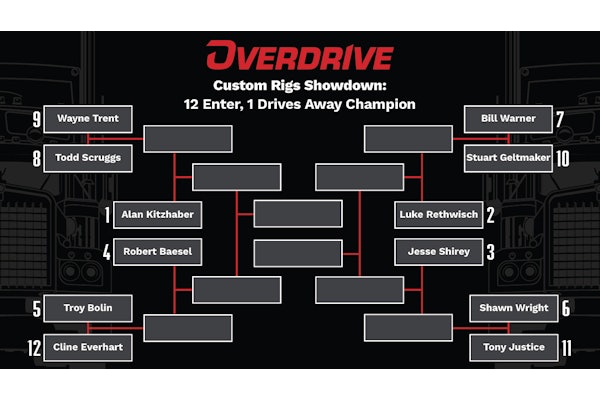Fighting Fatigue
Recognizing and dealing with drowsiness can help prevent costly accidents.
Telltale signs are excessive blinking, head bobbing, trying to refocus your eyes. You find yourself drifting in your traffic lane or into other lanes. You lose track of mile markers or miss your exit. You are surprised by overtaking traffic in lanes next to yours.
Taking a rest break out on the road will help fend off fatigue until you go off duty and can get sleep.It’s past time to pull off the road and take a break. You may be suffering from fatigue. Physical and emotional stress, sleep loss and prolonged work all result in fatigue and performance that is well less than 100 percent. Fatigue may increase the chances of sleepiness, but it’s not synonymous with sleepiness, says Dr. Jeff Durmer, chief medical officer for FusionSleep.
Recognizing you are fatigued may be difficult, Durmer says, because people often fight it. For many, warning signs are the inability to keep your eyes open or committing errors of commission — shifting gears when it’s not necessary — or omission, such as failure to look at your speedometer or notice your turnoff. “It’s unfortunate that a lot of these errors are not something we can detect personally before they happen,” he says.
Other signs you may be suffering fatigue are headaches or blurry vision, Durmer says, or maybe you’re unable to concentrate.

Gerald P. Krueger, PhD, principal in Krueger Ergonomics, says the most common response when truckers are asked how they know they are too drowsy to continue driving is when their eye scan pattern is compromised. As Krueger tells it, drivers say, “All of a sudden another vehicle shows up at my left front bumper.”
Sleep to stay awake
Don’t reach for the thermos. Studies have found that drinking coffee, rolling down the window in cold weather and other stimulants don’t work very well, Durmer says.
Bob Stanton, a company driver for a major national carrier, says fatigue is something that all long-haul drivers have to manage daily. “It’s part of the work environment we’re in,” he says. “Any driver has to recognize when they’re fatigued and that it’s time to stop and take a nap.” Stanton says he’s easily rejuvenated by taking a 30-minute “power nap.”
When he feels drowsy, owner-operator Brian Chute naps or walks to get revived.Owner-operator Brian Chute, leased to Transmaxx, says he schedules two 30-minute breaks into his workday and spends them walking or napping. If he’s driving and feels the “yawns and leans” coming on, he’ll call a buddy and start a conversation for stimulation.
Napping helps if you’re not getting adequate sleep during your 10 hours off duty. Krueger says one of the aims of hours of service rules was to provide sufficient time for commercial drivers to get 7-8 hours of sleep every 24 hours. That works in theory, but conditions on the road often make it difficult, especially if you drive at night and sleep during daylight hours. Physiologically speaking, the body isn’t normally meant to be sleeping during the day, and daytime sleepers usually sleep less than needed. Additionally, other rigs leaving, arriving and idling make truckstops noisy places to sleep.
Anti-idling ordinances contribute to driver fatigue, Stanton says. “How do you expect a long-haul over-the-road driver to get restful sleep in a truckstop in the Mojave Desert sleeping from 2 p.m. to midnight to be in compliance with hours-of-service regulations?” he asks.
Company driver Bob Stanton says 30-minute power naps help him combat fatigue.Driver fatigue is independent of hours-of-service rules, Krueger contends. He says he knows of drivers who comply with HOS regulations who nonetheless are fatigued. “From your body’s circadian rhythm standpoint, probably the best time to be driving is from 6:30 to 8:30 at night because that’s when your body temperature is rising at its fastest rate,” he says. “At about 10:30, your body is saying it’s time to go to sleep.”
Operational choices help industry grapple with fatigue
Sam Faucette, safety director for Old Dominion Freight Line, says to lessen fatigue his company tries to reduce the amount of driving between the operator’s 10th and 11th hours on duty. A study last year found only 2 percent of driving was performed in that time window. “We try to avoid that period as much as we can,” he says.
Durmer says the drivers who might be most susceptible to fatigue and sleep issues are drivers who have to switch between day- and night-shift driving. “Drivers need to stay on their circadian rhythm,” he says. “The risks of nighttime driving for daytime drivers are astronomical.”
Staying awake for long periods can contribute to fatigue and have detrimental results. A study found that the ability to perform normal tasks declined markedly in people who stayed awake longer than 15 hours, Durmer says. Wake time beyond 17 hours — say 6 a.m. to 11 p.m. — equated with the effects of a 0.05 blood alcohol level.
Fatigue presents problems for fleets. If a driver has to pull over and take an unscheduled sleep break, he runs the risk of missing a delivery time, which can cost the carrier.
Fleets also know that federal regulations are coming that will involve drivers, sleep and fatigue, says Mary Parrish, vice president of transportation safety for FusionSleep. The Federal Motor Carrier Safety Administration will probably make a recommendation to the U.S. Department of Transportation regarding commercial drivers’ licenses and sleep apnea testing. “They don’t know if that’s going to happen in a year, two years or five years, depending on how fast the legislation takes,” she says.
Fatigue’s impact on trucking is difficult to measure, Krueger says. Accidents caused by a sleeping driver can be counted, but there are undoubtedly many others in which the driver was sleepy and made mistakes or his evasive driving skills were compromised. “There are tremendous cost implications for an employer who has a driver involved in a fatigue-related crash,” he says. Proper testing, training and monitoring of drivers for sleep-related problems could help a carrier avoid the $3.5 million average cost of a lawsuit arising from a fatal crash.
Fatigue’s medical impact
In addition to sleepiness, fatigue presents other health concerns for truckers. Dr. Jeff Durmer of FusionSleep says stress that occurs with fatigue can lead to serious medical problems.
Research has found that lack of quality sleep can cause various chronic diseases, such as congestive heart failure, hypertension, type 2 diabetes and coronary artery disease, which can lead to heart attack and stroke. Sleep disorders also can cause weight gain.
Dr. Jerry P. Krueger of Krueger Ergonomics says it’s difficult to say that if you are hypertensive, obese or not physically fit, you are more likely to be in an accident. “However, there have been a large number of crashes where the driver might have had a cardiovascular incident,” he says.
Types of fatigue
Drivers can experience the effects of various types of fatigue, according to Gerald Krueger, principal in Krueger Ergonomics:
Operator fatigue “is a state of mind and body, a response to continued physical or mental activity or sleep loss, characterized by diminished ability to do work, loss of attention, slower reactions, poor response, deterioration of vigilance or alertness and impaired judgment.”
Physical fatigue “is a temporary loss of muscle power to respond to demands. It is a feeling of muscular tiredness, soreness or discomfort, usually from performing sustained work. Physical performance decreases over time.”
General mental fatigue “is a feeling of tiredness after extended or repeated performance, particularly of non-physical tasks like driving. It may include feelings of monotony or boredom due to lack of novel stimulation.”
General fatigue “can be caused by inadequate rest, sleep loss and/or disrupted sleep, displaced biological (circadian) rhythms, excessive physical activity or mental and cognitive work, extended length of duty days, especially over 12 hours, and it can be [worsened] by general psychological stresses of life at home or at work.”
Acute fatigue “is a short-term condition mostly resulting from missed sleep; it can be relieved by adequate rest and sleep.”
Chronic fatigue “results from repeated and cumulative stress, is akin to ‘burnout’ and may require an extended break, such as a vacation or a holiday.”
Drowsy driver warning signals
If you’ve been awake too long or driving too many miles since you last stopped, you may feel the effects of drowsy or tired driving. Here are some indications that you need to pull off the road and take a break, Krueger Ergonomics’ Gerald Krueger says.
• It has been more than five hours since your last rest-break from driving.
• You slept fewer than seven hours in the previous 24.
• You are driving in one of two circadian lulls of the day: 1-4 p.m. or 1-4 a.m., when your body temperature is lower and drowsiness becomes apparent. Your mood and performance have declined.
• You are behind the wheel at sunrise after driving through the night and are experiencing a competing physiological drive to fall asleep.
• You have feelings of drowsiness, such as increasing yawning, frequent blinking and head nodding.
• Your concentration is waning, with wandering thoughts and reduced awareness of your surroundings.
• Your decision-making is slower, and your driving judgments aren’t as crisp, quick or effective as they should be.
• Your visual scan pattern to rearview mirrors has degraded. You are surprised by overtaking traffic.
• Your situational awareness is less. You have lost awareness of your location on the map and aren’t sure where you are.
• You unknowingly passed a planned highway exit or missed your planned turnoff point.
• You don’t remember recent mile markers.
• You experience sporadic variations in vehicle speed.
• You are failing to follow road sign instructions or respond to them slowly.
• You are following too closely to traffic in front of you.
• You brake intermittently — sleepy drivers apply brakes more often than needed.
• You are shifting gears more frequently and erratically and grinding gears, particularly in city traffic.
• You are driving over rumble strips at the road shoulder of road — a sign of “sleep lapse” or “microsleep.”
• You are experiencing hallucinations, seeing strange things that really aren’t there.







